Hypersensitivity of an Arabidopsis sugar signaling mutant toward exogenous proline application
- PMID: 10859207
- PMCID: PMC59046
- DOI: 10.1104/pp.123.2.779
Hypersensitivity of an Arabidopsis sugar signaling mutant toward exogenous proline application
Abstract
In transgenic Arabidopsis a patatin class I promoter from potato is regulated by sugars and proline (Pro), thus integrating signals derived from carbon and nitrogen metabolism. In both cases a signaling cascade involving protein phosphatases is involved in induction. Other endogenous genes are also regulated by both Pro and carbohydrates. Chalcone synthase (CHS) gene expression is induced by both, whereas the Pro biosynthetic Delta(1)-pyrroline-5-carboxylate synthetase (P5CS) is induced by high Suc concentrations but repressed by Pro, and Pro dehydrogenase (ProDH) is inversely regulated. The mutant rsr1-1, impaired in sugar dependent induction of the patatin promoter, is hypersensitive to low levels of external Pro and develops autofluorescence and necroses. Toxicity of Pro can be ameliorated by salt stress and exogenously supplied metabolizable carbohydrates. The rsr1-1 mutant shows a reduced response regarding sugar induction of CHS and P5CS expression. ProDH expression is de-repressed in the mutant but still down-regulated by sugar. Pro toxicity seems to be mediated by the degradation intermediate Delta(1)-pyrroline-5-carboxylate. Induction of the patatin promoter by carbohydrates and Pro, together with the Pro hypersensitivity of the mutant rsr1-1, demonstrate a new link between carbon/nitrogen and stress responses.
Figures
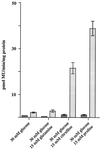
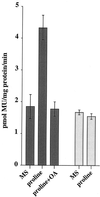

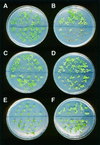
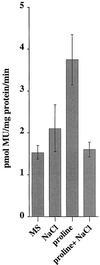
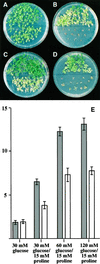
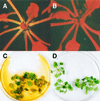

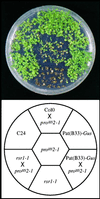
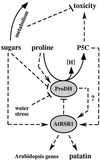
Corrected and republished from
-
Hypersensitivity of an Arabidopsis sugar signaling mutant toward exogenous proline application.Plant Physiol. 2000 Feb;122(2):357-68. doi: 10.1104/pp.122.2.357. Plant Physiol. 2000. Corrected and republished in: Plant Physiol. 2000 Jun;123(2):779-89. doi: 10.1104/pp.123.2.779. PMID: 10677429 Free PMC article. Corrected and republished.
References
-
- Balibrea ME, Rus-Alvarez AM, Bolarin MC, Perez-Alfocea F. Fast changes in soluble carbohydrates and proline contents in tomato seedlings in response to ionic and non-ionic iso-osmotic stresses. J Plant Physiol. 1997;151:221–226.
-
- Bates LS, Waldren RP, Teare ID. A rapid determination of free proline for water-stress studies. Plant Soil. 1973;39:205–207.
-
- Blum A, Ebercon A. Genotypic responses in sorghum to drought stress. III. Free proline accumulation and drought resistance. Crop Sci. 1976;16:428–431.
-
- Büssis D, Heineke D. Acclimation of potato plants to polyethylene glycol-induced water deficit. II. Contents and subcellular distribution of organic solutes. J Exp Bot. 1998;49:1361–1370.
Publication types
MeSH terms
Substances
LinkOut - more resources
Full Text Sources
Molecular Biology Databases
Miscellaneous

